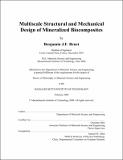| dc.contributor.advisor | Christine Ortiz. | en_US |
| dc.contributor.author | Bruet, Benjamin J. F. (Benjamin Jean Fernand), 1980- | en_US |
| dc.contributor.other | Massachusetts Institute of Technology. Dept. of Materials Science and Engineering. | en_US |
| dc.date.accessioned | 2009-01-26T22:01:00Z | |
| dc.date.available | 2009-01-26T22:01:00Z | |
| dc.date.copyright | 2008 | en_US |
| dc.date.issued | 2008 | en_US |
| dc.identifier.uri | http://hdl.handle.net/1721.1/44200 | |
| dc.description | Thesis (Ph. D.)--Massachusetts Institute of Technology, Dept. of Materials Science and Engineering, 2008. | en_US |
| dc.description | This electronic version was submitted by the student author. The certified thesis is available in the Institute Archives and Special Collections. | en_US |
| dc.description | Includes bibliographical references (p. 211-222). | en_US |
| dc.description.abstract | Gastropod mollusk nacre tablets and Polypterus senegalus armored scales share common features such as a very complex and changing structure spanning several length scales. The smallest building blocks are single crystals, have dimensions of a from tens of nanometers to several microns and are intimately blended with an organic glue present within pores or between the crystallites. In particular, our results strongly suggest that nacre tablets possess nanoscale porosity in the form of elongated tubules that may contain the intratablet macromolecules. Their unique structure allows these materials deform in a ductile way at the nanoscale, with no cracks observed, and to confine deformation at the microscale so as to impede crack propagation. Gradient in the mechanical properties are ubiquitous at both the microscale (scales) and the nanoscale (nacre tablets), preventing stress concentration and enhancing strain distribution. The armored scales thus exhibit a unique spatial functional form of mechanical properties with regions of differing levels of gradation within and between material layers, as well as layer with an undetectable gradation. Though highly mineralized, these biomaterials also exhibit greater local heterogeneity in their mechanical properties compared to pure minerals. Materials layers have distinct morphology and mechanical properties depending on their role (resistance to abrasion for harder outer layers, resistance to fracture for tougher inner layers) and their interface are reinforced (by anchored organic fiber ligaments and corrugated interfaces that maximize contact surface., preventing propagation of cracks both through and along the interfaces. | en_US |
| dc.description.abstract | (cont.) The heterogeneity in size and shape of the crystallites and the pores, as well as the variation in the composition (mineral / organic, crystalline amorphous) are likely responsible for the desirable variations of mechanical properties as observed in these biocomposites at the smallest length scales, resulting in more spatially distributed strains and greater energy dissipation. | en_US |
| dc.description.statementofresponsibility | Benjamin J.F. Bruet. | en_US |
| dc.format.extent | 222 p | en_US |
| dc.language.iso | eng | en_US |
| dc.publisher | Massachusetts Institute of Technology | en_US |
| dc.rights | M.I.T. theses are protected by
copyright. They may be viewed from this source for any purpose, but
reproduction or distribution in any format is prohibited without written
permission. See provided URL for inquiries about permission. | en_US |
| dc.rights.uri | http://dspace.mit.edu/handle/1721.1/7582 | en_US |
| dc.subject | Materials Science and Engineering. | en_US |
| dc.title | Multiscale structural and mechanical design of mineralized biocomposites | en_US |
| dc.type | Thesis | en_US |
| dc.description.degree | Ph.D. | en_US |
| dc.contributor.department | Massachusetts Institute of Technology. Department of Materials Science and Engineering | |
| dc.identifier.oclc | 275179510 | en_US |
